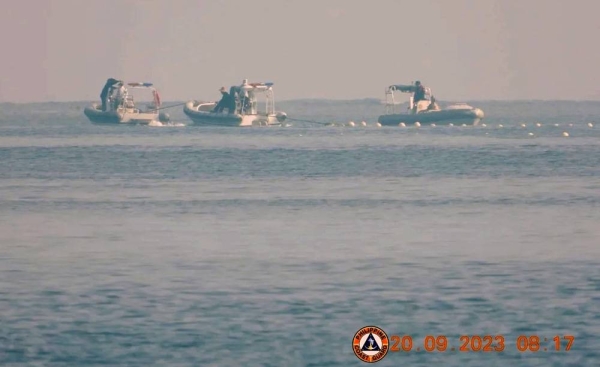
A Chinese Coast Guard ship blocked a Philippine patrol vessel in the South China Sea, causing a near collision in waters where Beijing"s vast claims have alarmed the US and its allies.
The BBC witnessed the tense encounter near Second Thomas Shoal in the remote Spratly archipelago last Sunday - a move that Manila says is straight out of Beijing"s playbook. And it happened the day after Philippines" President Ferdinand Marcos Jr met Chinese Foreign Minister Qin Gang in Manila, and expressed hope for open communication lines on the South China Sea dispute.
Throughout the 1,670km (1,038-mile) journey of two Philippine Coast Guard ships over six days, news cameras captured how - on cue and in specific locations - Chinese ships would shadow or tail the Filipinos, and send them radio warnings to leave or face "consequences". The Philippine Coast Guard said it had invited journalists to join their routine patrol in the hotly-contested waters for the first time to witness China"s actions for themselves.
China claims almost the entire South China Sea, including the Spratlys, which is also claimed in part by the Philippines. There are also competing claims by Malaysia, Vietnam, Brunei and Taiwan.
This has turned the South China Sea into the one of the world"s biggest flashpoints, especially as US-China tensions have soared. For one, access to these waters is key to defending Taiwan at a time when China"s claims over the self-governed island have intensified. And second, the waterways also host $5tn (£4tn) of global trade every year, raising concerns that Beijing"s increasing footprint could restrict commerce.
But China has ignored an international arbitration court"s ruling that its claim to almost the entire South China Sea is ill-founded. It has instead built artificial islands over reefs, heightened patrols, and more recently, shone lasers at Philippine ships to obstruct their view.
The Philippines, on the other hand, has leaned on its long-standing ally, the US, which brands China"s moves as disruptive of other countries" "freedom of navigation".
When the stand-off happened, the US and the Philippines were in the final days of their largest ever war games. This came on the heels of the US gaining access to key Philippine military bases, many of which face Taiwan.
China made "highly dangerous maneuvers" at Second Thomas Shoal and Filipino officials were well within their authority to routinely patrol the area, the Philippines foreign ministry said. Beijing, on the other hand, accused the Philippines of intrusion into Chinese waters.
"China has long used tactics like shadowing, but now, because of the media, the whole world gets to see it," said Commodore Jay Tarriela, spokesman of the Philippine Coast Guard.
At dawn on 23 April, the Filipino crew noticed how the Chinese ship that had been shadowing their vessel Malapascua increased speed, as shown by the thick black smoke from its exhaust. The BBC witnessed the high seas chase playing out on relatively calm turquoise waters from a second Philippine ship, the Malabrigo, roughly one kilometre away.
Eventually the Chinese ship caught up with the Philippine boat, and it became clear that the latter could not outmaneuver a vessel more than twice its size. The Chinese ship blocked the way and refused to budge, forcing the Malapascua to turn off its engine to avoid a collision.
The Chinese ship came as close as 45m (146ft) to the Malapascua"s bow due to the "sudden and really very dangerous maneuver", said the Philippine ship commander, Rodel Hernandez. It was the closest near-collision for his vessel, which was also involved in a laser incident with the Chinese in February, he said.
After a 30-minute stand-off, the Philippine ships turned away and were unable to patrol the Second Thomas Shoal, one of the few disputed outcrops and islands that Manila occupies by parking a rundown Navy ship - the Sierra Madre - on it with a handful of marines.
China"s routine blocking of Filipino patrols and supply missions to the Second Thomas Shoal was part of the case brought before the Permanent Court of Arbitration in 2016. The shoal is a rich fishing ground and its Filipino name, Ayungin, is taken from a tiny local fish.
Journalists who joined the patrol also witnessed what life has been like for the Philippine Coast Guard as the South China Sea dispute festers.
Crewmen on board the two patrol boats have ready scripts to warn or respond to Chinese ships. The radio warnings from the Chinese could come at any time of day, even in the dead of night, and are delivered in English and Chinese.
In recent weeks, some Chinese ships have refused to respond to warnings from Filipinos, in an apparent new tactic. Some Chinese militia ships have also turned off a tracking mechanism to appear invisible on radar.
The coastguard mission also found some 100 militia ships near V-shaped Whitsun Reef, in the Spratlys" coral region.
It said it had informed a cabinet body tasked to handle the South China Sea dispute about China"s recent actions.
Together with other Philippine security forces, the coastguard said it would "diligently and tirelessly work to protect the Philippines" exclusive sovereign rights". — BBC












